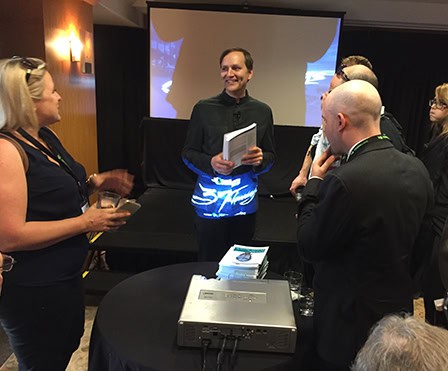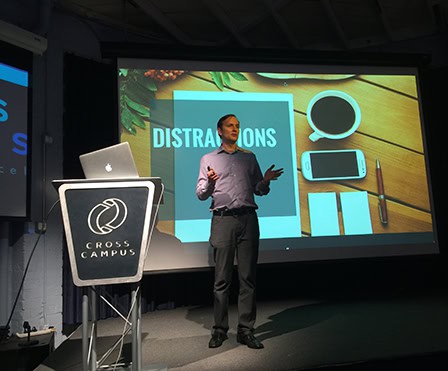In this Episode
- [01:24]Stephan shares a quick story about his first meeting with Mike, who then explains more about what he did during the incident in question.
- [06:51]Mike explains how he can use the techniques he’s been describing in real life rather than in the particular situation he’s talked about.
- [08:07]Mike discusses the patterns of eye movements and what these can indicate about a person’s thinking patterns.
- [11:37]We learn more about the trick of having someone tell a story backwards to see whether it’s true. Mike then offers another tip for detecting lies.
- [13:16]About 80% of people in the American penitentiary system have a trait in common in their handwriting. Mike then tells a story about reading a postcard from his late father and finding a deceit in it.
- [16:40]Does eliminating negative traits in your handwriting make you a better person?
- [18:15]Mike offers a couple of tips for how listeners can add strength and power to their personality with simple handwriting changes.
- [19:57]Stephan brings up some characteristics of his own handwriting, and Mike addresses what they mean.
- [22:48]Mike discusses the types of handwriting he’s looked into, and describes how to access his entire graphology training.
- [24:22]We learn more about how the words we use change our experiences. Mike points out that learning a new language changes our perception of time, and discusses the use of the word “try.”
- [27:21]What are some words we should avoid when trying to influence someone? As part of his answer, Mike offers a powerful story of why it’s so important to tell someone under stress to “remain calm” rather than “don’t panic.”
- [31:36]Mike moves on from talking about “don’t” to talking about “can’t.” He then discusses offering a double bind, in which either of two alternatives gets you exactly what you want.
- [35:13]Two incredibly powerful words you can use to amplify someone’s behavior are incredibly simple: “that’s right.”
- [37:09]Mike explains the power of the word “because” through a compelling (and entertaining) story about getting a teenager to clean his room.
- [43:05]Stephan jokingly tries Mike’s techniques back on him.
- [43:58]Mike shares one of his favorite moments from being a therapist.
- [47:49]Mike turns the story he has just shared into a valuable takeaway for listeners, explaining how to apply the technique to everyday situations.
- [49:30]How can you persuade someone to give you what something like a hotel room upgrade (for example) for free?
- [52:59]We learn why not to ask someone “what’s wrong?”, but rather “what do you want?”. Mike then explains the power of quoting someone (anyone!) else when you’re saying something unpleasant.
- [55:51]Mike talks about how to learn more from him and take advantage of the training that he offers.
Transcript
You are feeling very sleepy. I’m going to be counting backward. No, never mind, you might be driving. Hypnosis and NLP, neuro-linguistic programming, in other words, are game-changers in terms of persuasion, understanding others, and understanding yourself. What you’re about to learn from NLP expert and trainer Mike Mandel, you can use to persuade to create breakthroughs for yourself and others to even detect lies as they’re being spoken. Hi, I’m your host Stephan Spencer. In this week’s episode, you’re going to learn NLP from someone who is widely regarded as the world’s greatest hypnotist, with six awards and 18 nominations to back that up. Welcome, Mike Mandel. It’s great to have you on the show.
It is awesome to be here.
I got to share a quick story. One of the memorable experiences of working with you in Neil Strauss’s Secret Society was when you chose me from the audience to demonstrate something really cool, a lie detector test. You had me turn to beat red thinking about some embarrassing situations. I’d love for you to share your process in how this works because it made me quite memorable in society for that particular thing that happened. Share that with our listeners.
Human beings work the same way as polygraphs. We don’t detect lies but we detect the difference.
Sure. I have no recollection of that, your honor. I’ll tell you what happened. It is an effect I’ve been doing for many years. I used to demo hypnosis and I also taught the Advanced Interviewing Module at the Ontario Police College. One evening after an event, we were talking about truth and lies. There was a man there who was from a company called Toronto Polygraph. I said, “I think the human neurology and psychology is the best polygraph there is.” He said, “What do you mean?” I said, “Well, human beings work the same way as polygraphs. We don’t detect lies but we detect the difference. If you have a baseline of when someone is telling the truth, then when they deviate from it, it becomes relatively easy if one is being observed and then calibrating the person, determining when they’re actually lying.” He said, “That’s intriguing. Show me,” so I demoed it for him. One of the guys said, “Man, you got to work this into your show,” my lie stage show. I said, “But it’s not entertainment.” He said, “No, but it’s highly entertaining.” It also found its way into lectures I do, one of which you saw. I’m demonstrating the whole point of calibration and state. We get someone sitting down in front of the group to think of something embarrassing, something that they don’t like to think about, and they don’t verbalize it, they just think about it and I watch them. When they give an unconscious nod, an ideomotor signal, I know they’ve gone into that state exactly.
At that moment, I release the hand that I have pressed on their left shoulder or right shoulder whichever it is. At the moment they know that I released my hand, which tends to set the anchor at the peak state. Meaning, I can now elicit that state by touching their shoulder again. Then I’ll sometimes stack a few embarrassing things or maybe something that annoys them, drunk drivers, or whatever it is. I keep stacking these on top of that anchor, unless I get a really good one right away. As I do this, I’m watching the person closely. Then I’ll produce a deck of cards, the person can shuffle them, I can turn my back, and they take one, memorize it, and put it on the chair and sit down on it so nobody knows what it is but them. The other cards are put back in the case and put out of the way. Then I get to think of that card intently. The sequencing of this might vary from event to event but essentially this is the process. They think of the card really intently. When they do, I touch their other shoulder in a way I can replicate. When they got it, this card burns into their mind, they give me a nod, I remove my hand and set the anchor with the playing card on the other shoulder.
Now we have a series of anchors stacked or at least one bad one on one shoulder that will elicit a negative or embarrassing state. We also have a playing card anchor which will bring that card fleetingly back into their mind on the other shoulder. And then I demonstrate these which tend to strengthen them. I’ll say, “You’re sitting on a playing card, just an ordinary card. It looks like this and your demeanor.” I’ll touch the shoulder and the person who sits there and the audience is watching. I’ll say, “But on the other shoulder, we have something far more significant.” When I touch the shoulder, you see all the bad state come to the surface. The person might blush, some people fidget, something will show up. This is what I’m calibrating, this is what I’m watching for because this will give me the artifacts of what their embarrassment state looks like. Then, I’ll fire them both together. We take the playing card anchor and add the embarrassment anchor by firing them at the same time.
Actually, because I’m dealing with two shoulders, I’m dealing with two hemispheres of the brain; right shoulder left hemisphere, left shoulder right hemisphere. By firing the anchors at the same time, this is actually causing a neurological change in the brain. It’s not their imagination. We are building new neural pathways, new neural connections at the rate of about one million per second on average. This burns in a neural pathway where cells become connected to each other, neuronally connected. When I now start asking about the playing card that the person is sitting on, because it’s being connected to the embarrassment state, the person starts to show signs of embarrassment as I close in on the card, which I believe is what I probably did with you. I offer money generally up to about $200, I don’t go any higher than that. And then I can get the one card out of 52 the person’s sitting on. It’s not a bet, they have nothing to lose. If they can trick me into thinking it is any of the other 51, they win. I think I must have won if you had the response you did.
Yeah, you won. It was very entertaining for everybody. How do you use this information practically? If you’re really good at reading people’s body language, you don’t need a polygraph, you can tell when people are lying. You can watch their eyes and all that.
I can’t detect lies just talking to someone but I can detect changes and shifts.
Not quite, not quite. In this game although I do, I am a student of body language, that’s not what I’m doing here. What I’m doing is sorting for the difference. I’m tuning my calibration skills. As a hypnotist, I’m calibrating people all the time, mostly unconsciously. But if I’m in a therapeutic session with someone, I’m calibrating the subtle changes in their external analog behavior to a very high degree so I can notice when things change. I can’t detect lies just talking to someone but I can detect changes and shifts. Facial tone, facial color, lower lip size, all of these things, breathing shifts, and then it’s how we interpret them, that is the art form.
Right. Let’s say that you’re watching somebody’s eyes and you’re asking them to recall different information, or scenes from the past, or whatever, and describe them, and something shifts, something is different in one of those stories and their eye patterns. You taught how to analyze where people are looking is indicating where they’re accessing in their brain information, or memories, or making stuff up, their imagination. Could you explain how that all works?
Yeah, sure. I’ll give you a stripped-down version here, Stephan. What basically we’re talking about here, eye accessing patterns that a lot of people have attempted to dispute and disprove but they really work. The strength of a model is in its usefulness. They go back to Richard Bandler and John Grinder in the 1970s where they’d be dealing with someone psychotherapeutically. Notice as we all do when we’re talking to people, be aware that they are not typically just staring at us unless they’re Hannibal Lecter. Their eyes are doing what’s called a transderivational search. They’re moving all around in about seven different patterns; up to the left, up to the right, the horizontal line left and right, down to the left, down to the right, and then straight ahead on focused. These different patterns are concomitant with shifts that are happening in the thinking process, consciously, or unconsciously at that time, mostly unconsciously.
The way we can utilize this in the most simplified version, let’s just talk about the visual sense because we all process the world, the external world all the time according to visual, auditory, and kinesthetic information. Visual being the sight obviously. Auditory being sound, words, music, etc. Kinesthetic being feelings, emotions, and physical touch. In a kinesthetic sense, there are subgroups, olfactory and gustatory sense as well. What Bandler and Grinder discovered is if someone is a typically right-handed person and they look up into their left, they’re accessing what are known as eidetic visual imagery. Eidetic just means of course seen before. If I look up into my left, being a typically right-handed person, I’m accessing the left occiput in my head, the left sight center at the back of my brain. When you are creating an image instead of remembering one, if you say to someone, “What does the front door of your house look like?” They look up to the left to get the information, the eidetic information that they remember. But if you say, “What would your grandmother look like with purple hair and green skin?” They’ll look up into the right and go, “Weird.”
They’re creating this image using the other hemisphere of their brain, in this case, it’ll be the left one. Let me clarify, I’m thinking of looking at someone, I’m explaining it reverse. If I look up into my left, I’m accessing my non-dominant hemisphere, the right brain. If I look up into my right, I’m accessing the dominant hemisphere, the left brain. When I’m creating new images, I’m looking up into my right and I’m accessing the left brain in the occiput. The way this works is if you ask someone to tell you a story and a true story, something simple that happened to them, doesn’t have to be emotional at all. It could be just a trip they took, a camping trip, whatever. Tell you a true story but hide one piece of information in it that is false. If you know the eye accessing patterns, you’ll notice that they suddenly deviate from remembering, remembering, remembering to constructing. You let them tell the entire story. When you get to the end, you say, “Yup, that was all true except that canoe wasn’t red, was it?” “Shut up, how do you know?” You say, “Because I can read your mind.”

That is so awesome. What would be another example of detecting lies? You’re watching their eyes. I remember something about you get them to tell a story backward.
Yeah. That’s a classic trick. When someone gives you a story and you don’t know if it’s true or not, it could be an alibi. Why are you late or where were you? They give you the story and you act as though you completely believe it, nod and smile, so that their guard is down and they commit to this. And then at the end of the story, you then run it backward, you say, “What happened just before that?” They say, “I told you, I was at the mall.” “No, no, no. Before you’re at the mall, what did you say?” “I said I was at Dave’s house.” “No, no, no. Before you got to Dave’s house, what did you do?” “Oh, I can’t remember what I said.” See, when people lie, they typically rehearse a story only forwards. When you run it out of sequence, the lies show up very, very quickly. Whereas if something really happened, you just remember.
That is so cool.
I’ll light another one for you, Stephan. A great one is too much information. If someone is telling you something and you don’t know if it’s true or not, pause and don’t say anything. If they keep going, and keep going, and keep going, they’re probably lying. Because they feel like they’re not convincing you because they don’t sound convincing to themselves I guess and they’ll just continue. Too much information is crucial. Typical indicator of someone who is lying at that time. Because if I say to you, “Oh yeah, I was at the mall.” I really was, I just stop but if I say, “I was at the mall. I got there at exactly [2:30] and I so and so,” that’s probably a lie. Overly detailed.
Right. Love it. Let’s say that you’re just looking at somebody’s handwriting, I know you’re a handwriting expert. You can tell just by looking at certain ways they draw their letters that this person is a felon.
Yes. Or has predisposition to it, let’s say. There’s a trait called a felon’s claw that appears according to Andrea McNichol in about 80% of the handwriting of people in the American Penitentiary System and it appears to be consistent worldwide. There are other things too. You can tell even in a particular sample of writing if there’s a lie or a falsehood written in there. It’s great to look at old birthday cards, Christmas cards, and things. You can see things subtle changes like differences in size. “It was really great to see John and Mary.” The person’s written John in big letters and Mary is much smaller. You can tell which person is more important to them right away. John is, Mary is being belittled by being shrunk down in the handwriting unconsciously. You can also notice a lie in the text of handwriting when someone is writing and there’s a sudden space that is too big, that’s standing out, there’s nothing like it in the rest of the text probably, but there’s sudden space in front of an area that is too big and it’s obviously different. Everything that follows that, something that immediately follows it is probably false. Because the person is thinking what to say and their hand is still moving. That little half a second of continued motion on the hand before the lie will give it away.
You can notice a lie in the text of handwriting when someone is writing.
That’s amazing. You could tell if somebody is lying without even meeting them, without even talking to them, just looking at their writing. It’s so cool.
Oh, it’s startling, yeah. This is how weird this is. When I was about 10 years old, which is when you were still a gleam in the milk man’s eye. I must have been younger than that, that’s probably eight or nine. My father went to New York on a business trip for Bell Telephone Company in Canada with some other guys. My father is a very straight-laced ex-British army, royal engineers type, grew up in Toronto though. I did, he didn’t. We came to Toronto when I was a kid. He went on this business trip and brought me back the typical New York souvenirs; pencil case with the Statue of Liberty and Empire State Building on it, a couple of things like that. I thought it was amazing. I forgot about this. About 15 years ago, we found some old letters and postcards that my parents must have had in drawers, my parents are long since deceased. My dad died in 1981, my mom in 1977. My sister and I found a postcard written in pencil which is a great way of telling graphological traits. Pencil tends to show them very easily because it will show variances in pressure, as well as just shape and form and so on and size. We found this postcard he’d sent home from New York. In the handwriting was an indicator of deceit. My dad was the most straight-laced, un-deceitful guy I knew. I can’t deny that writing never lies. I don’t know what happened in New York but there was something on that trip, he was definitely hiding. Knowing how straight-laced my dad was, it was probably something no more than he had four beers one night and said he had one. It was probably nothing worse than that but it was astounding that that deceitful imprint stood the test of time and was still visible 50 years later.
Wow. That’s amazing. If you wanted to become more truthful, or more virtuous, whatever, you just start changing your handwriting, eliminate your felon’s claw, and you’ll become a better person.
As crazy as it sounds, that really appears to be the case. I’ve worked with dozens of clients graphol therapeutically where the bases of them, most of the therapy has been examining their handwriting, deconstructing it, explaining to them who they are. When they realize how accurate it is, they are not resistant at all, and then telling them the key things they need to change in the writing. We have one case, a guy Steven from Montreal. He was one of my hypnosis students. His writing was among the most unstable I’ve ever seen. The guy was in an emotional mess, he was failing in his job, all kinds of difficulties as a swimmer, young guy. We took him under our wing. He took my hypnosis training. I taught him how to change his writing. He practiced for about 10 minutes a day and developed an entirely new type of handwriting for him that was very stable. As far as the slant went stable in size, and margins, how we removed some nasty traits and built-in self-reliance. In fact, all of your listeners can make a great change in their handwriting. I’ll tell you at the end of this anecdote. A couple of months later, we saw him again. I’m telling you, this man is absolutely transformed. He’s a brand new person, he’s a swimming coach now, he’s stable, he’s happy, and he has just consistently maintained this new writing which he posts on my online graphology group. It’s a beautiful sample of writing and he has become the sample. We don’t say fake it till you make it. I like what Amy Cuddy says, fake it until you become it.
Noel Bunker discovered close to 100 years ago that people who underline their signature tend to be self-reliant.
That’s a great way. I’ll tell you a couple of things that your listeners can do to immediately add strength and power to their personality. One of the things you can do is ensure that every single time you sign your name, 100% of the time, you underline it with a single left to right underscore. A nice, straight left to right line that goes under the entire signature but does not cut through it at all, unless you have descending loops like Gs or something, that’s okay but not through the body of the signature. Under it, one understroke. Noel Bunker discovered close to 100 years ago that people who underline their signature tend to be self-reliant. Meaning, when the chips are down, and they have no support from other people, they can go it alone. That’s a great trait to have. The other one I recommend is looking at your small letter Ts when you write. I know everybody texts know, I do too. Everybody sends emails but we’re still capable of writing, most of us at least. If you practice, get a journal and practice. Make your small letter Ts so the bar that crosses them goes left to right, not right to left, which will put a critical voice in your head. It’ll criticize you. Every time I see a right to left T bars, I tell the person, “You got a critical inner voice.” “Shut up, everybody does, don’t they?” “No.” You can remove that by going left to right with the T bars. Its will power directed itself when it goes backward and that’s bad. Have the person raise their T bars higher on the stem, they’re much higher up, longer, heavier pressure, and pointed upward slightly, this will build in the traits of enthusiasm, perseverance of will, high goals, and optimism, which are all great things to have.
That’s so cool. I love that. Oh, a couple of things just come to mind immediately. When I write an F, I don’t write the top bar, whatever you want to call it, is never fully completed. It’s almost like a T. And then I edit because if I look at it, this is almost unconscious. I just add it at the top because it doesn’t look like an F, it looks like a T. I wonder what that means. My Gs and other letters that require a loop for me to draw, they’re like an O type thing, I won’t complete it. It’ll be open.
Open. That’s a really interesting trait. Do your other circle letters do that too? The O and the A?
Yeah. Yes.
That’s an interesting trait. That’s the desire to communicate one’s true feelings and thoughts. It’s not surprising you have a podcast.
Ah, okay. Interesting.
An open circle letter, the graphological term is talkativeness but it doesn’t mean talkative as we mean it. It’s a specific term. It means the desire to share one’s true thoughts and feelings. It appears in Os, As, Gs, and sometimes even small letter Qs. If there’s any gap, the thoughts will come pouring out.
Wow. I was taught as a child, it’s best to be seen and not heard. I was stifled a bit there a lot actually as a child. I don’t just have one podcast show, I have two. I have Marketing Speak as well as Get Yourself Optimized. I keep thinking about maybe I need a third one too.
Absolutely fantastic. See, you are a born communicator. You have broken the mold that other people attempted to put on you and I applaud you for that.
Oh, thank you. What does the F mean? When I don’t draw the full top of the F.
Are you talking about the small letter F?
Small letter F, yeah.
Yeah. You don’t do the typical one with the upper and lower loop. Do you do a printed F with a line across?
Yeah. It looks like a T because I don’t complete it. If I didn’t add the line at the top, it would almost look like a T. There would be a little bit of the horizontal line.
The stem would go a little bit to the right but that’s it.
Yeah. That’s it.
Right. I know what you mean, yeah. That’s more idiosyncratic than anything. That isn’t any clear marker that I know. The only thing is if they were really, really tall and rounded on the top, it looks like a shepherd’s crook and that’s a really interesting trait. I’ve only seen it a couple of times and you do not have that, by the way. That’s a trait of the ideological zealot, somebody who’s a religious fanatic, the cult leader, they have those.
Ahh, interesting. Have you looked at some of the writings of those kinds of people, founders of religions, and stuff and found that?
All sorts of people. Yeah, I’ve looked at everything. In my course that I teach in Toronto, at the University of Toronto we do it once a year actually. We’ve now turned it into an online product. My entire graphology training is available online. Can I give the URL?
Writing never lies.
Oh for sure. Yeah.
It’s mikemandelhypnosis.com. On there, if you click on trainings, my entire graphology training is online and can be purchased and done there. We use to teach it in two days at UOT. By shooting it properly with HD cameras and having it edited, the entire training is available worldwide. We have a lot of police do it now. We have one who’s a deputy sheriff in Louisiana. We have another one in Britain. We have two lawyers who have done the course and they say it’s absolutely changed their practice of law because the writing never lies. It’s pretty wild.
Wow. Not only can you change your wiring and how you show up in the world by changing your handwriting, but you can also do this in the words that you say too. When you are using the word try for example or you’re using don’t or different words that are more negative, it’s like there’s an embedded command in there.
Right.
You’re basically throwing resistance in the way instead of allowing yourself to make things happen and to do what you say you’re going to do. Let’s talk about the words that you say.
Yeah, the neurolinguistics. The neurolinguistics of it all. You’re banging on with that. Let me just close the other point before I forget. It’s not the hand that writes, it’s the prefrontal cortex of the brain. It sends a signal down the hand. It’s a complex neuromuscular function. God forbid you ever lose the use of your hand, I know people learn how to write with their teeth, or the crook of their elbow, or even some people their toes, a pen between their toes. Once they become fluid with the writing, guess what, it shows their identical personality that the other writing did from their hand. We know now, since it’s a continuous loop from brain to hand and back again, if we change the brain, if the person’s stoned, or drunk, or is suffering from Parkinson’s disease, the handwriting will change. Likewise, if we change the handwriting, it sends a signal back and the personality changes. There is a neuroscience behind the theory. Back to the power language, yeah, neurolinguistics, it is amazing how framing our language will change our experience. In fact, when one learns a different language, our entire perception of time changes. That was intrinsic to the film Arrival, how the alien language changed their perception of time when they learned it. I won’t do any spoilers, but it’s quite an interesting film.
I love that movie.
Yeah, it’s cool, wasn’t it? Likewise, if we change the way we frame the words through our language, things change. That’s the most basic example. I have to do this and then I have to do this. I get people to say I get to do this. See, because I have to walk and carry all these thing and then get to because you’re not in a wheelchair. You’re not paralyzed, this is something you get to do that they would love to be able to. When you change something to a get to instead of I have to, you’re experience changes. That’s the most basic thing. You mention try, Stephan, that’s a great example. We know intuitively that try means we’re going to fail. It’s even built into our language. If at first, you don’t succeed, try, try again, and fail, and try, and fail. I tell people, as soon as someone says, “I’ll try,” this illusion is you immediately say, “Is that a yes or a no?” but you say it nicely. “Well, it’s a no.” “Okay, that’s fine.” If someone gives you a no, there’s nothing wrong with that, because now you can keep searching until somebody else gives you a yes but a try leaves you hanging there. I tell people, “Don’t offer I’ll try.” Of course, that’s not the same as, “Oh, I’ll try it on for size and see how this works for me.” That’s a totally different thing, but an effort to accomplish something, “I’ll try, I’ll try to show up, I’ll try to be on time.” We already know it’s not going to work.
Great. Let’s say that you’re trying to, trying…
I heard that.
Let’s say that you want to influence somebody and the words that you choose are very powerful in your ability to do that or not. What would be some words that you want to avoid? I’m guessing maybe don’t.
Right. If you’re using don’t, as soon as someone’s under stress, you’re getting stress chemicals in the bloodstream cortisol and epinephrine and so. When that happens, the critical faculty of the brain [27:18], the part of your brain that access of our mind, technically access of firewall to prevent information getting into the unconscious and influencing you, it temporarily goes offline to greater and lesser degrees. That’s why when people are in shock, their critical faculty is essentially gone. They’re essentially in a hypnotic trans at that moment. That’s when you don’t want to use don’t because in order to process negatives, we’re funny things, human beings. If I say, “Don’t think of a pink elephant.” The only way you can make sense at the sense is to momentarily think of a pink elephant and then go that’s what we don’t want. Put a line through it. We handle negatives through deletion. We make a positive in 1/30 of a second then we delete it. If you don’t have a critical faculty, a little kid doesn’t. They’re formed in age, some between ages four and seven, something like that, by modeling authoritative figures, teachers, parents, and so on, people they trust.
Until then, they believe anything. If you say, “Hey Tommy, there’s a purple dragon in the hall. He’s got a big box of candy for you.” If Tommy is four years old, he’s going to run and check. He’ll come back and be confused and say, “You know Stephan, there’s no purple dragon out there with a box of candy from me.” You’d laugh and say, “Of course not son. You don’t have a critical faculty, you don’t realize how ridiculous all this is.” He’ll believe anything. Because if I say to you, “Go, there’s a purple dragon in the hall with candy,” you know it, dragons don’t exist. They’re probably not purple if they do and a chance of them being pervasive confectionaries is extremely remote. The critical faculty protects us from believing everything. We stop believing just anything and everything. But when we’re under stress, the critical faculty very quickly goes offline. And then we respond like a little kid which is why you don’t want to come out to your hotel room late at night. Someone’s running down the hall and it woke you up. He’s yelling, “Oh there’s a fire. What do we do? The smoke, we can’t take the stairway, there’s smoke down there. We can’t use the elevator, it’s going to take us right to the floor where the fire is. I saw that in a movie.” You try to be, try is the word here, try to be in control, and say, “Don’t panic.” What’ll happen is because his critical faculty is offline, in 1/30 of a second, he’ll make a representation of what panicking means but instead of deleting it he will amplify it and will go from panicking to over panicking.
Alright, so instead of don’t panic, you tell them to calm down.
Remain calm, that’s the key thing. The pre-supposition is that they are calm and this is so ridiculously powerful. I taught this to many, many people including Virginia Department of Criminal Justice and Microsoft and New York State Troopers. When I taught this to some police in Ontario, Canada, a policewoman stood up in the audience and she said, “I heard you teach on this couple of years ago. I’m going to tell you how I use this.” She was the first Ontario Provincial Police Constable on the scene, North of Toronto in the winter in a very bad car accident where somebody had gone off the road, hit block ice. The passenger was dead, hadn’t been wearing a seatbelt, the driver was severely injured with a broken leg twisted at a crazy angle, part of the engine block had come through to the front seat and he’s leaking blood rapidly from the femoral artery and the inside of his leg. She looks in, puts her thumb in the artery to stop the bleeding, he looks down, sees his buddy is dead, goes into shock. PGO spike, his critical faculty goes offline and he says, “I’m going to lose my leg, I’m going to lose my leg. They’re going to amputate.” And she remembered this and said, “Remain calm.” And he went, “Okay.” It was ridiculous, he just immediately changed completely and calmed right down. Here’s your cue, everybody listening. When you’re dealing with people under stress, and I’m currently getting stressed by somebody outside who’s using what sounds like a snowblower in the middle of June, I’m hoping he’s going to stop soon. If you’re dealing with someone under stress, don’t use ‘don’t’ because you’ll get the opposite of what you want because they’ll make the internal picture of what that thing means but they won’t always get around to deleting it.
If you’re dealing with someone under stress, don’t use ‘don’t’ because you’ll get the opposite of what you want because they’ll make the internal picture of what that thing means but they won’t always get around to deleting it. Click To TweetOkay. Don’t is a really bad word, how about can’t? That’s not a good one either.
Can’t is a bad one too because it tends to shut down the very resources we need. The old adage is If you say you can or can’t do something, you’re probably right. It becomes a self-fulfilling prophecy. But you don’t want to lie to yourself and say you can do something when you can’t because lying to yourself is still lying. For example, if you want to go skiing for the very first time in your life and you decide to go to Vail, Colorado without any lessons because you’re being so optimistic and positive and you’re telling yourself, “I can ski.” Convincing yourself, you buy $10,000 of great equipment and go to the top, ski around in Vail mountain and proclaim to the universe, “I can ski.” Fleeing yourself into space, you’ll discover you can die. Because lying to yourself is lying so what we say is put it in process. I am learning to ski instead of I can ski. Let your brain work on that. Right now I am learning French, I want to be fluent in French by the end of this year because I have snippets of a number of languages. But I want my French to be my best because Canada is technically a bilingual country. I don’t say, “I can’t speak French.” I won’t lie and say, “I can.” But I say, “I’m learning French.” And my unconscious mind goes, “That’s cool. I can deal with that.”
Nice, that is so powerful. You can use that all the time.
Let me give you another one of influence, Stephan. You made me think of this when you’re asking earlier, it popped into my mind. It’s not specific words but it’s a principle. If you want to influence other people, one of the most powerful things you can do is offer what is known as a double bind. A double bind only offers two alternatives but it ensures that either one gets you exactly what you want. You determine in advance what you want and then you offer the person would you rather have this or would you rather have this? The weird thing about human nature is when we are presented with only two choices, we tend to choose one of them instead of looking for a third, fourth or fifth choice. This is ridiculously powerful. Salespeople who are well trained or intuitively know this, use it all the time. They’ll say things like, “Do you want to sign the contract now or should we wait until after lunch?” What about the third one? I’m not going to sign it at all. The tendency is to say, “Well I haven’t got time for lunch, I guess we better sign it now.”
Then afterward, you’ll be amazed, you don’t even know what happened. It’s so powerful that years ago my wife didn’t use to drink much water. She comes to my family where my father had kidney stones. Back in the days when they didn’t use shockwaves and break them up nicely while you’re sitting in a bath of water. They used to cut you wide open with incisions big enough to throw a football around. I didn’t want her to get kidney stones and there’s a definite connection with inadequate water and she was never thirsty. I was always saying, “Got to drink more water.” And she goes saying, “Yeah I’m not thirsty, never mind.” One day she was sitting reading the paper and I just walked in and she was distracted and said, “Would you rather have a hot drink now or a cold drink later?” She looks surprised and she’s like, “What?” I said, “Would you prefer a hot drink now or a cold drink later?” She thought for a moment and said, “I’ll have a hot drink now.” I said, “That’s right.” I’ll bring you a cold drink later. I brought her a cup of herbal tea, she drank it and I brought her a bottle of water and she drank that. What did you just do? Offer people double binds; make sure either alternative will get you exactly what you want, plan it in advance.
That is so cool. You also use something that I remember from the training, that’s right and that goes right into your subconscious. Tell us about it.
Double binds are your friend. Watch out for them being used on you.
It’s a powerful thing. Then that’s right goes back to [00:35:06] and it’s like a universal hypnotic amplifier. When someone is offering any kind of behavior like I tell my students when someone starts to look like they’re going into hypnosis, you see the changes beginning to happen. All you say is that’s right and that amplifies it and makes it stronger, whatever is happening. Years ago someone from the U.S. came to Toronto doing a weekend-long hypnosis training which isn’t sufficient to really learn in-depth but I went and took the course and claimed no previous experience just to see what they’re teaching because we think we offer the finest online and in-person hypnosis training in the world. I checked this out, there were 19 of us in the class. He said, “Okay now it’s time to do the hypnosis.” About halfway through the first day and he said, “But someone is going to have to sit this out. It’s an odd number.” He said, “Unless someone wants to hypnotize me.” My hand flies up and he seems surprised. I went up to the front and the entire induction was based on a double bind. I just put two chairs down and said, “Would you rather have the hypnosis chair or the trance chair?” He said, “What?” I said, “Would you prefer the hypnosis chair or the trance chair?” He said, “I guess I want the hypnosis chair.” I said, “That’s right.” That started the trance process because there’s a thing here operating called the tacit contract. What that means is tacit means unspoken. If he says I want the hypnosis chair, he has accepted the contract that he will go into hypnosis. If he says I want the trance chair he’s accepted that he’s going to go into trance but they’re exactly the same thing. Double binds are your friend. Watch out for them being used on you.
You’re right. Or if the people are manipulating you and throwing in it because of some ridiculous thing that has nothing to do with what they’re asking you to do. You taught that one.
They’re dreaded because, you raised a great one at that, you were clearly paying attention, went to that lecture because it’s a great one. Basically, Robert Cialdini reports on it in his book Influence. The idea is when you want someone to do something, if you use because, provided everything in front of that word is a stand-alone command, you can put an exclamation mark after, then the reason you give doesn’t matter. The example given was there was a photocopier at a university just for the use of the students back when you needed photocopiers and nobody had computers. Everyone was in line to those, 20 or 30 kids in line to use this thing. The psychology department gave their 2nd-year students the task of jumping into the very front of the line using whatever verbal methods they could to see what would work, pushing ahead of everyone. Not surprisingly, sometimes they went to the front of the line, sometimes they didn’t. But it was discovered that every time they use the word because in a certain way, they went right to the front of the line. They were literally saying, “Let me in line because I have to make photocopies.” So did everybody but people were going, “Sure, go ahead.”
Because let me in line is in front of the word because, it is a stand-alone command. It’s an embedded command that slips past the critical faculty into the unconscious mind and causes a response. You couldn’t say, “Will you let me in line?” That’s a question. You wouldn’t say, “Please let me in line.” Because that’s a request. You just say, “Let me in line because I have to make photocopies.” The people don’t even take into account how ridiculous it is when they’re letting them in. 100% of them got in line using this method. It’s so powerful. A woman who was one of the top 2% real estate agents in Canada came up to an event that I was at and said, “I would like to tell the group how I used this.” I said, “Go ahead.” She said, “I’m a real estate agent, I got a big house. I’m a single mom but I got a big house and my son’s bedroom is bigger than some people’s houses.” I still remember her 15-year-old son’s name is Scott. She said he has not or had not cleaned his bedroom in over two years. It was disgusting because there’s a garbage dump, there’s stuff under the bed, dirty socks, half-eaten bananas and chocolate bars; just a mess. She said, “I refused to do it.” I said, “That’s a good start.” She said, “I threatened him, pleaded with him, controlled him, offered to reward him and nothing worked. Then I found out about this and determined I was going to go home and get him to clean his room.”

I said, “What did you do?” She said, “I opened the door he was sitting on his bed with earplugs in. He pulled them out and said, “What now?” Thinking he’s in trouble again.” She just looked at him with intention and said, “Scott, clean up your room because we’re going out tomorrow.” He looked surprised, did a transderivational search. His eyes going through all the brain systems comes up with nothing and said, “What did you say, mom?” She just repeated, “I said clean up your room because we’re going out tomorrow.” He stopped for a second and went, “Okay, mom.” Got up and started cleaning. She said she staggered out the hall, fell against the wall, and went, “Yes, how can this be so easy? After fighting with him for so long.” She said the result was in 90 minutes he was done and she said, “If I said it was clean like a mother had cleaned it, I’d be lying. But he took six bags of garbage out of that room and never made the connection clean up your room because we’re going out tomorrow.” Which in fact they weren’t; it’s just weird stuff.
Wow. You can also emphasize the embedded command if it’s in the middle of a sentence.
Yes, absolutely. Any time you take a sentence fragment that can be a command and you say it differently by pausing in front of it, dropping your voice when you say it, looking at the person as you say that part of the sentence, pointing at them to mark it, that will tend to slip past the critical faculty into the unconscious and be hypnotic. The key is to do it subtly enough that the conscious mind doesn’t notice but obviously enough that the unconscious catches it. A classic example, years ago we were coming back, my wife and I with another couple, from Montreal to Toronto which is a five-hour drive from a wedding of someone I didn’t even care about. Now that I’m 64 I wouldn’t even have gone to it because life’s too short, would’ve made some excuse or just said no. We’re driving on a highway 401, which is a very big highway. It’s pouring rain and I’m driving. I had a Volvo back then which you can lock the back windows and doors from the front for the kids. John and Janet, our friends were in the back seat, my wife and I are in the front and they were all reading. I’m like, “Come on guys, talk to me.” “No, we’re reading.” Reading is boring, I turned the radio on and blast of little bit of Black Sabbath to wake up. “Turn that down, it’s disturbing to us.”
I turned the radio off and I paused and I said, “You know on a long trip it’s easy to begin to get car sick.” I just dropped my voice, I changed the pitch when I said, “…begin to get car sick.” My wife knows me, after we’ve been married 36 years now I still call her my first wife to keep her on her toes. But she looks at me like, “That’s not getting in.” Because if you heard consciously, your critical faculty’s caught it, but John and Janet in the back seat were not so lucky. After about two minutes Janet goes, “I feel really sick, wind the windows down.” Her husband goes, “I feel sick too.” I locked the childproof windows up, put the heater on full, and start swerving side to side like a motorboat and said, “How do you feel now?” Fantastic. I took mercy on them and put the windows back down. But they didn’t hear it consciously and it’s what you said Stephan, you got past through the critical faculty hypnotically and embedded command just by saying it differently. My friend Dr. Paulin is a professor of psychology at Algoma University. He’s also the Dean there, it’s classical psychology. Hypnosis is his specialty but he doesn’t do the side of it. He said, “Mandel, if what you’re saying is true then hypnosis is happening all the time.” I said, “That’s right.”
Okay. Let’s say that you were to let me have complimentary access to your handwriting training because we’re on this podcast together. You could imagine all sorts of good things happening because of that.
Yeah, I think I could. Hang on, you’re doing it on me.
I love this. This is so cool. It’s like a superpower.
I’m easy, I’m the good cop. My business partner Chris, he’s a bad cop.
Sometimes you’re in a one-on-one scenario with somebody and sometimes you’re with multiple people and you can have good cop, bad cop. Let’s talk about if you’re in a therapy session and you’re trying to influence somebody, I’m thinking there’s this one story that really sticks out in my mind you told when you were sniffing under your watch.
Yeah, that was my finest hours. When I was a therapist in the ‘90s I was doing a lot of it, a lot of really quick stuff. I had a really nice office not far from Lake Ontario and Toronto; a beautiful upscale area in the city and little place. Now the guy turned off his snowblower and turned on some kind of alarm system.
That’s okay, don’t worry about it. Oh, I just said don’t. Just remain calm.
A pattern interrupt intrudes chaos into the person’s state that is so bizarre that if you do it a few times, it scrambles their state and they can’t get back in again.
Is it a worry now or panic later? Would you rather have the electric chair or the dentist’s chair? We do double blinds out there. Anyway, I was working out of this office and we did a lot of really rapid therapy because of the same things that have happened in microelectronics and psycho-pharmaceuticals. The same shifts have happened in neuroscience in the last 20 years. We can now get to things very quickly and I’ve had the best teachers in the world. I’m so blessed, thank God I’m standing on the shoulders of giants. People like Dr. John Grinder and William Lamers from Switzerland. A Swiss psychologist, my mentor that Derek Bomber since passed away. I learned from great people. We learned to make rapid changes quickly and one of the things we would do is a pattern interrupt. A pattern interrupt intrudes chaos into the person’s state that is so bizarre that if you do it a few times, it scrambles their state and they can’t get back in again. The best way to think of this is think of a dense forest and you’re the first person to walk through. You come back a couple of weeks later and you walk the same route again and then again. Then other people start to follow that route through.
Eventually, you start to make a pathway, you get the sticks get pushed out of the way, the road gets smoothed down and the plants die off in that area. The pathway becomes so obvious more and more people go through it and it becomes much more navigable for that reason. The same thing happens to the brain; it’s something called Hebb’s law. Hebb’s law says that neurons that fire together wire together. In other words, when two neurons fire together, they’re shaking hands with each other and it increases the chance of them doing it again. The potential for it and over the long term it becomes permanent; they become wired together. You get this pathway in your brain whether it’s a habituated pattern. Every time I see that guy I blow up or someone who’s drawn to alcohol they can’t stop drinking. We get these patterns. Sometimes just pushing the person out of that pattern can be very powerful. I’ll give the example you mentioned and then I’ll help people use it in their own lives so we got a takeaway for you here. This woman came and she had five open-heart surgery including a replacement of an aortic valve, just terrible. Blood thinners panicking and she became very, very anxious and depressed. Basically, all I did was get her talking about her depression. When she was in that state, I kept yanking her back out of it by interrupting it.
Then I’d let her sink into it further and then asked her some completely irrelevant questions like do you have a brother? What’s his middle name? She’d have to exit the state to answer, we’re loosening the toll pulling her in and out. Then finally I let her go in it full blast and I start smelling underneath my wristwatch because I was distracted. She said, “What are you doing?” I said, “Nothing.” “You’re smelling under your watch.” I just deny it, “No, I’m not.” I kept screwing up her state by doing things like that. Finally I was smelling the wall socket electrons and offering them to her she said, “This is humiliating. Am I going to find myself on Youtube next week? Dr. Rome said you could help me, this is terrible.” I said, “Sit down and tell me about your depression.” She said, “No you’re going to start smelling stuff again.” It just got really weird. I said, “Okay tell me about your depression now.” I see a transderivational search for her eyes and she said, “That’s weird, it seems to be.” I said, “Gone?” She went, “Yeah.” Then I teach her how to rewire her brain by doing different choices instead, so we’re building a new pathway. Here’s the takeaway for your awesome listeners. Say there’s something in your life you don’t like, test it on something small first.
I’ll give you an example. We got some relatives who have been absolutely problematic and abusive. My wife and I discuss them and when we discuss them, we get in bad states and we’d wind up discussing them for hours. It was a total waste of time. What we did instead was every time we’d start to think of them, you got to catch it at the beginning of the pathway to have the maximum effect. Instead, I would physically out loud and say, “Stop.” Hold up my hand like a stop sign. I would push the picture of what I’m talking about further away and then replace it by saying something like, “I’m done with them not living a good life.” First, you have to do it a lot. An hour later I started thinking about it I’m like “Stop.” Push the picture away, shrink it down while pushing it away and say, “I’m having a good life, I’m done with that.” Guess what? A few days later it just stopped because the pathway starts to die out. There’s neuroscience behind it, it’s not doing a trick on yourself. You’re actually rewiring your brain and the new pathway is far more enjoyable.
Amazing. I love that story, I never get tired of it. Let’s talk about how you can persuade somebody. Let’s say you’re at the hotel checking in and you want an upgrade for free. We get an idea from what you’re describing earlier with the because. Let’s talk about your three-step process that I’ve used many times and it’s amazing. I’ve gotten lots of upgrades for free and so forth because of this. Share this with our listeners if you could.
This is a really easy one. Neil Strauss calls it mandeling someone. It’s not my own technique, it’s a classic assertiveness training but what I’ve done is modify it to make it even more powerful. You’re now getting a version 2.0 or 3.0, Stephan, because I’ve found a way distilling it even simpler. The old idea was whatever the person does to try to manipulate you or if they’re trying to sell you a product you don’t want or you want to return something to a store and they say, “We don’t give refunds.” Any time you have to be ultimately assertive, get that upgrade on that hotel. You state your purpose, you tell them what you want. You say, “I want a full upgrade to a better room.” Then they give you their excuse, “Well I’m sorry but we don’t have any upgrades available this month. We’re not permitting them.” You agree with what they’ve said you say, “I’m sure you don’t but I want a full upgrade to a better room.” You say it again, you don’t even have to think about it, you can be daydreaming. They say, “My manager said that I’m not qualified to deal with this.” You agree with that, you say, “I’m sure you’re not but somebody is and I want a full upgrade.” You just keep saying it, you agree with whatever they say so you are offering zero resistance.
You become like a fog bank, by offering no resistance you give them nothing to fight with.
You become like a fog bank, by offering no resistance you give them nothing to fight with. You just keep agreeing with whatever they’re saying. They say, “I don’t think this is fair.” You say, “I’m sure it isn’t but I still want a full upgrade.” Here’s the simplified model. You don’t even have to agree with what they said. The old model was I know how you feel but I want my money back. You’re probably right but I want my money back. That makes sense but I want my money back. Get to think of these vague terms, now we’ve reduced the entire thing to one word, understood. No matter what they say, you don’t interrupt them, you say, “Understood but I want a full refund.” “We know, it’s our policy and we’ve had six months to this.” You let them finish without interrupting at all then you hit the delete key by saying, “Understood but I want full refund.” It’s unbelievable. People say, “How many times do I have to do it?” I say, “Just one more time than they do, that’s it.” How will I know if it’s worked? When you get what you want. What if it doesn’t work? Say it again. What if I get what I want? Stop saying it.
You’ll notice that they go into the transderivational search at some point. You’ve gotten past their critical faculty.
Yes. Bang on with that, Stephan. They will suddenly stop and hear you for the first time and they’ll do the transderivational search. At that point, all their resistance and anger has been diffused and you’ll have no issue with them at all. It’s actually wonderful.
Because they’re just on autopilot saying, “Sir I don’t have the authority to do that.” I understand that the manager is the person who does this and I still want an upgrade. Is there a difference between using but or and? Or does that not?
Yes there is. When you use and, it’s called a string sentence. The police would use this all the time. It enables them to disengage from people when they have to and offers no resistance. It values what they’re saying and makes them feel understood. “I hate him. I want to kill my brother, I want to shoot my brother.” The police used to say, “Get down.” Now it’s, “I understand you want to kill your brother and let me put these handcuffs on you.” You validated them by saying you understand it and let me put these handcuffs on you. Some people don’t like saying but even with this technique. They don’t want to say, “Understood but I’m not doing it.” Or “Understood but I want a full refund.” Just change but to and, it works just as well.
Don’t ask what’s wrong too, you taught that one.
Yeah, never ask what’s wrong. They’ll unpack all the nasty stuff. Ask people what they want instead of what’s wrong. The list of what’s wrong or what you don’t want is infinite, people always hear what they don’t want. I don’t want this and I don’t want to feel unhappy. You also don’t want to run a tin mine on Jupiter, you don’t want to do root canals on yourself, you don’t want to set a bonfire in your bedroom. The list of what you don’t want is infinite, that’s the takeaway. Focus on what you want, guys, and let the powerful reticular activating system of your brain lead you to that.

This is so cool, one more. I just can’t resist. How about when you’re quoting somebody else, when you’re saying something bad.
Yeah, you can say anything to anyone if you quote somebody else. A friend of mine, his boss used to drive him crazy and he said, “I wish I could get back at him.” I said, “I’m your guy. I got thousands of interventions, come over tonight. I’ll teach you one.” He said, “You’d do this?” I said, “Yeah, therapist by day, counter-therapist by night.” He comes over and I just told him I said, “Get in his face and say what you’ve always wanted to say to him.” He says, “He’ll kill me.” I said, “No. Nothing will happen but you’ll put him in a really weird state. You’re going to quote somebody else because as soon as you quote someone else and point at them as you say the quoted part, you’re now sending an embedded command that their unconscious will get. You could say anything to anyone if you quote someone else but you’ve got to get their sensory channels open wide in the state we call curiosity where your sensory channels are like a vacuum cleaner. You do that.” He went in and said, “Oh this weird thing happened on the subway. Never mind.”
His boss said, “What is it?” “I don’t want to talk about it.” He said, “What happened on the subway?” You got him really curious then he got really close in front him. He said, “This guy came up, stood in front of me as I was exiting the subway and he pointed at me like this.” He points at him, “And he said,” as he looks him in the eye, “He said, ‘You’re an idiot. Everyone in the city thinks you’re insane.’ Then he stepped to walk away like this, why would he do that?” That whole thing, because he’s pointing at his face, stared at him, has been embedded, and gone into his unconscious. His boss Bill, Paul said it was hilarious. He said he was in a bad state for two hours. He knocked the printer off his desk which isn’t easy to do, shut a filing cabinet, drew on the web of his thumb, hung up on an important client. He said it was really funny until his brain figured it out and rewired it. But those two hours were highly entertaining.
Okay, we’re out of time and this was incredible stuff. Things for ourselves to work on our own psyche things, that we can use to influence. Only for good, though.
Only for good.
If somebody wants to take it to the next level, whether it’s handwriting or the words that you use, whatever. How do they get to the training again?
Yup, mikemandelhypnosis.com and we have a tab there for training. You can check out my brain software podcast, there are 83 of them and we’re still 5-star rated after five or six years. Not 4.8 but still 5. You can check it out on Youtube or on our website but all our training is there. You can find it online and get some really good stuff.
Awesome. Listeners, definitely check out his amazing podcast. You even offer live training too, correct?
Yes, we do. We got another one starting in Toronto in a couple of weeks. We do the Architecture Of Hypnosis three times a year. We’ve drawn people in from Finland, Norway, Ireland, two psychiatrists from Singapore, Australia, New Zealand, Egypt, India and all over Canada and the U.S. People are coming for a 5-day intensive training on hypnosis; people who are psychiatrists and people with no previous experience at all.
Amazing. Listeners, I can vouch for the incredibleness of Mike’s training because I experienced it multiple times as part of Neil Strauss’s Secret Society. You got to go. Folks, this is Stephan Spencer signing off and I’ll catch you on the next episode of Get Yourself Optimized.
Important Links
- Mike Mandel
- Mike’s podcast
- Mike’s graphology training
- YouTube – Mike Mandel
- Twitter – Mike Mandel
- Influence
- Neil Strauss
- Ontario Police College
- Eye accessing patterns
Checklist of Actionable Takeaways









 About Mike Mandel
About Mike Mandel
Mike Mandel is a qualified trainer of neurolinguistic programming (NLP) and is affiliated with NLPWorks, who offer Canada’s most complete NLP training. He teaches advanced Ericksonian hypnosis both via online training and in a live classroom in Toronto, the hypnotic world epicenter. Widely regarded as the world’s greatest hypnotist, Mike Mandel has 18 nominations and 6 awards for excellence in entertainment. In June 2000 he was presented with the COCA Hall of Fame Award, previously won by Sarah McLaughlin, the Tragically Hip, and Jim Carrey.
Disclaimer: The medical, fitness, psychological, mindset, lifestyle, and nutritional information provided on this website and through any materials, downloads, videos, webinars, podcasts, or emails is not intended to be a substitute for professional medical/fitness/nutritional advice, diagnoses, or treatment. Always seek the help of your physician, psychologist, psychiatrist, therapist, certified trainer, or dietitian with any questions regarding starting any new programs or treatments, or stopping any current programs or treatments. This website is for information purposes only, and the creators and editors, including Stephan Spencer, accept no liability for any injury or illness arising out of the use of the material contained herein, and make no warranty, express or implied, with respect to the contents of this website and affiliated materials.
LOVED THIS EPISODE
Please consider leaving me a review with Apple, Google or Spotify! It'll help folks discover this show and hopefully we can change more lives!
Rate and Review








 About Mike Mandel
About Mike Mandel










